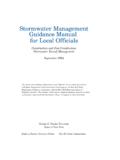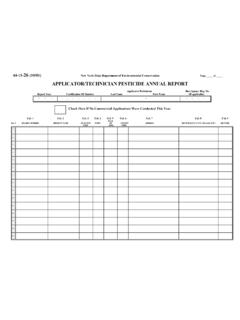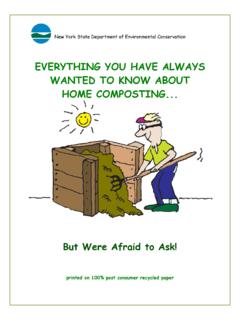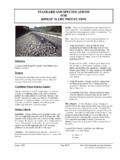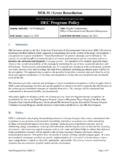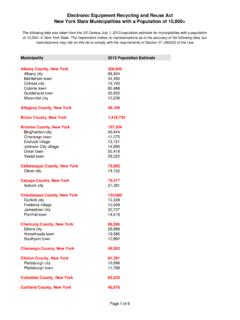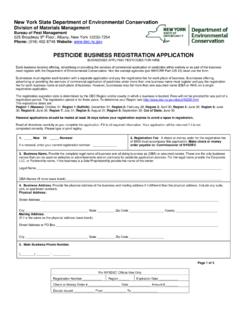Transcription of SAMPLING, ANALYSIS, AND ASSESSMENT OF PER- AND ...
1 SAMPLING, ANALYSIS, AND ASSESSMENT OF PER- AND POLYFLUOROALKYL SUBSTANCES (PFAS) Under NYSDEC s Part 375 Remedial Programs June 2021 June 2021 Table of Contents 7 7 Field Sampling 7 Analysis and 8 Routine Analysis .. 8 Additional Data ASSESSMENT and Application to Site cleanup .. 9 water Sample Results .. 9 Soil Sample 9 Testing for Imported 10 Appendix A - Quality Assurance Project Plan (QAPP) Guidelines for 11 Appendix B - Sampling Protocols for PFAS in Soils, Sediments and Solids .. 12 Appendix C - Sampling Protocols for PFAS in Monitoring Appendix D - Sampling Protocols for PFAS in Surface 16 Appendix E - Sampling Protocols for PFAS in Private water Supply Wells.
2 18 Appendix F - Sampling Protocols for PFAS in Fish .. 20 Appendix G PFAS Analyte Appendix H - Laboratory Guidelines for Analysis of PFAS in Non-Potable water and 29 Appendix I -Data Review Guidelines for Analysis of PFAS in Non-Potable water and Solids .. 31 2 June 2021 ERRATA SHEET for SAMPLING, ANALYSIS, AND ASSESSMENT OF PER- AND POLYFLUOROALKYL SUBSTANCES (PFAS) Under NYSDEC s Part 375 Remedial Programs Issued January 17, 2020 Citation and Page Number Current Text Corrected Text Date Title of Appendix I, page 32 Appendix H Appendix I 2/25/2020 Document Cover, page 1 Guidelines for Sampling and Analysis of PFAS Sampling, Analysis, and ASSESSMENT of Per-and Polyfluoroalkyl Substances (PFAS)
3 Under NYSDEC s Part 375 Remedial Programs 9/15/2020 Routine However, laboratories However, laboratories analyzing environmental 9/15/2020 Analysis, analyzing environmental and PFOS in drinking water by page 9 and PFOS in drinking water by EPA Method 537, or ISO 25101. EPA Method 537, , ISO 25101, or Method 533. Additional None In cases where site-specific cleanup objectives for 9/15/2020 Analysis, PFOA and PFOS are to be assessed, soil page 9, new parameters, such as Total Organic Carbon (EPA paragraph Method 9060), soil pH (EPA Method 9045), clay regarding soil content (percent), and cation exchange capacity parameters (EPA Method 9081), should be included in the analysis to help evaluate factors affecting the leachability of PFAS in site soils.
4 Data ASSESSMENT and Application to Site cleanup Page 10 Until such time as Ambient water Quality Standards (AWQS) and Soil cleanup Objectives (SCOs) for PFAS are published, the extent of contaminated media potentially subject to remediation should be determined on a case-by-case basis using the procedures discussed below and the criteria in DER-10. Target levels for cleanup of PFAS in other media, including biota and sediment, have not yet been established by the DEC. Until such time as Ambient water Quality Standards (AWQS) and Soil cleanup Objectives (SCOs) for PFOA and PFOS are published, the extent of contaminated media potentially subject to remediation should be determined on a case-by-case basis using the procedures discussed below and the criteria in DER-10.
5 Preliminary target levels for cleanup of PFOA and PFOS in other media, including biota and sediment, have not yet been established by the DEC. 9/15/2020 3 June 2021 Citation and Page Number Current Text Corrected Text Date water Sample Results Page 10 PFAS should be further assessed and considered as a potential contaminant of concern in PFOA and PFOS should be further assessed and considered as potential contaminants of concern in groundwater or surface water (..) 9/15/2020 groundwater or surface water (..) If PFOA and/or PFOS are identified as contaminants of concern for a site, they should be If PFAS are identified as a assessed as part of the remedy selection process in contaminant of concern for a accordance with Part 375 and DER-10.
6 Site, they should be assessed as part of the remedy selection process in accordance with Part 375 and DER-10. Soil Sample Results, page 10 The extent of soil contamination for purposes of delineation and remedy selection should be determined by having certain soil samples tested by Soil cleanup objectives for PFOA and PFOS will be proposed in an upcoming revision to 6 NYCRR Part 375-6. Until SCOs are in effect, the following are to be used as guidance values. 9/15/2020 Synthetic Precipitation Leaching Procedure (SPLP) and the leachate analyzed for PFAS. Soil exhibiting SPLP results above 70 ppt for either PFOA or PFOS (individually or combined) are to be evaluated during the cleanup phase.
7 [Interim SCO Table] P FOA and PFOS results for soil are to be compared against the guidance values listed above. These guidance values are to be used in determining whether PFOA and PFOS are contaminants of concern for the site and for determining remedial action objectives and cleanup requirements. Site-specific remedial objectives for protection of groundwater can also be presented for evaluation by DEC. Development of site-specific remedial objectives for protection of groundwater will require analysis of additional soil parameters relating to leachability. These additional analyses can include any or all the parameters listed above (soil pH, cation exchange capacity, etc.)
8 And/or use of SPLP. As the understanding of PFAS transport improves, DEC welcomes proposals for site-specific remedial objectives for protection of groundwater . DEC will expect that those may be dependent on additional factors including soil pH, aqueous pH, % organic carbon, % Sand/Silt/Clay, soil cations: K, Ca, Mg, Na, Fe, Al, cation exchange capacity, and anion exchange capacity. Site-specific remedial objectives should also consider the dilution attenuation factor (DAF). The NJDEP publication on DAF can be used as a reference: 4 June 2021 Citation and Page Number Current Text Corrected Text Date Testing for Imported Soil Page 11 Soil imported to a site for use in a soil cap, soil cover, or as backfill is to be tested for PFAS in general conformance with DER-10, Section (e) for the PFAS Analyte List (Appendix F) using the analytical procedures discussed below and the criteria in DER-10 associated with SVOCs.
9 If PFOA or PFOS is detected in any sample at or above 1 g/kg, Testing for PFAS should be included any time a full TAL/TCL analyte list is required. Results for PFOA and PFOS should be compared to the applicable guidance values. If PFOA or PFOS is detected in any sample at or above the guidance values then the source of backfill should be rejected, unless a site-specific exemption is provided by DER based on SPLP testing, for example. If the concentrations of PFOA and PFOS in leachate are at or above 10 ppt (the Maximum Contaminant levels established for drinking water by the New York State Department of Health), then the soil is not acceptable.
10 9/15/2020 then soil should be tested by SPLP and the leachate analyzed for PFAS. If the SPLP results exceed 10 ppt for either PFOA or PFOS (individually) then the source of backfill should be PFOA, PFOS and 1,4-dioxane are all considered semi-volatile compounds, so composite samples are appropriate for these compounds when sampling in accordance with DER-10, Table (e)10. Category B deliverables should be submitted for backfill samples, though a DUSR is not required. rejected, unless a site-specific exemption is provided by DER. SPLP leachate criteria is based on the Maximum Contaminant levels proposed for drinking water by New York State s Department of Health, this value may be updated based on future Federal or State promulgated regulatory standards.
